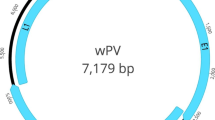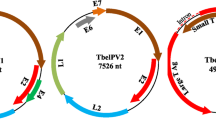Abstract
Fecal samples collected from free-ranging Atlantic bottlenose dolphins (BDs) in the Indian River Lagoon of Florida were processed for viral discovery using a next-generation sequencing (NGS) approach. A 693-bp contig identified in the NGS data was nearly identical to the partial L1 gene sequence of a papillomavirus (PV) previously found in a penile papilloma in a killer whale (Orcinus orca). Based on this partial bottlenose dolphin papillomavirus (BDPV) sequence, a nested inverse PCR and primer-walking strategy was employed to generate the complete genome sequence. The full BDPV genome consisted of 7299 bp and displayed a typical PV genome organization. The BDPV E6 protein contained a PDZ-binding motif, which has been shown to be involved in carcinogenic transformation involving high-risk genital human PVs. Screening of 12 individual fecal samples using a specific endpoint PCR assay revealed that the feces from a single female BD displaying a genital papilloma was positive for the BDPV. Genetic analysis indicated that this BDPV (Tursiops truncatus papillomavirus 8; TtPV8) is a new type of Dyopipapillomavirus 1, previously sequenced from an isolate obtained from a penile papilloma in a harbor porpoise (Phocoena phocoena). Although only a partial L1 sequence has been determined for a PV detected in a killer whale genital papilloma, our finding of a nearly identical sequence in an Atlantic BD may indicate that members of this viral species are capable of host jumping. Future work is needed to determine if this virus is a high-risk PV that is capable of inducing carcinogenic transformation and whether it poses a significant health risk to wild delphinid populations.


Similar content being viewed by others
References
Bernard HU, Burk RD, DeVilliers EM, zur Hausen H (2012) Papillomaviridae. In: King AMQ, Adams MJ, Carstens EB, Lefkowitz EJ (eds) Virus taxonomy: ninth report of the international committee on taxonomy of viruses. Elsevier Academic Press, New York, pp 235–248
Burk R, Chen Z, van Doorslaer K, Bernard H-U, Chan PKS, Desalle R, Dillner J, Forslund O, Haga T, McBride A, Villa LL (2015) ICTV taxonomic proposal 2015.014a-atD.A.v2.Papillomaviridae_10gen. Creation of 21 new species and 10 new genera in the family Papillomaviridae. https://talk.ictvonline.org/files/ictv_official_taxonomy_updates_since_the_8th_report/m/animal-dna-viruses-and-retroviruses/5818. Accessed 12 Dec 2017
Arbyn M, Tommasino M, Depuydt C, Dillner J (2014) Are 20 human papillomavirus types causing cervical cancer? J Pathol 234:431–435
Han R, Cladel NM, Reed CA, Christensen ND (1998) Characterization of transformation function of cottontail rabbit papillomavirus E5 and E8 genes. Virology 251:253–263
Bernard H-U, Burk RD, Chen Z, van Doorslaer K, Hz Hausen, de Villiers E-M (2010) Classification of papillomaviruses (PVs) based on 189 PV types and proposal of taxonomic amendments. Virology 401:70–79
de Villiers EM, Fauquet C, Broker TR, Bernard H-U, zur Hausen H (2004) Classification of papillomaviruses. Virology 324:17–27
Robles-Sikisaka R, Rivera R, Nollens HH, St Leger J, Durden WN, Stolen M, Burchell J, Wellehan JF Jr (2012) Evidence of recombination and positive selection in cetacean papillomaviruses. Virology 427:189–197
Otten N, von Tscharner C, Lazary S, Antczak D, Gerber H (1993) DNA of bovine papillomavirus type 1 and 2 in equine sarcoids: PCR detection and direct sequencing. Arch Virol 132:121–131
Munday JS, Thomson N, Dunowska M, Knight CG, Laurie RE, Hills S (2015) Genomic characterisation of the feline sarcoid-associated papillomavirus and proposed classification as Bos taurus papillomavirus type 14. Vet Microbiol 177:289–295
Halvorsen KM, Keith EO (2008) Immunosuppression cascade in the Florida manatee (Trichechus manatus latirostris). Aquat Mamm 34:412–419
Rector A, Bossart GD, Ghim SJ, Sundberg JP, Jenson AB, Van Ranst M (2004) Characterization of a novel close-to-root papillomavirus from a Florida manatee by using multiply primed rolling-circle amplification: Trichechus manatus latirostris papillomavirus type 1. J Virol 78:12698–12702
Bossart GD, Ewing RY, Lowe M, Sweat M, Decker SJ, Walsh CJ, Ghim SJ, Jenson AB (2002) Viral papillomatosis in Florida manatees (Trichechus manatus latirostris). Exp Mol Pathol 72:37–48
Ghim SJ, Joh J, Mignucci-Giannoni AA, Rivera-Guzmán AL, Falcón-Matos L, Alsina-Guerrero MM, Rodríguez-Villanueva M, Jenson AB, Bossart GD (2015) Genital papillomatosis associated with two novel mucosotropic papillomaviruses from a Florida manatee (Trichechus manatus latirostris). Aquat Mamm 40:195–200
Gottschling M, Bravo IG, Schulz E, Bracho MA, Deaville R, Jepson PD, Van Bressem MF, Stockfleth E, Nindl I (2011) Modular organizations of novel cetacean papillomaviruses. Mol Phylogenet Evol 59:34–42
De Guise S, Lagacé A, Béland P (1994) Gastric papillomas in eight St. Lawrence beluga whales (Delphinapterus leucas). J Vet Diagn Investig 6:385–388
Van Bressem M, Van Waerebeek K, Raga J (1999) A review of virus infections of cetaceans and the potential impact of morbilliviruses, poxviruses and papillomaviruses on host population dynamics. Dis Aquat Org 38:53–65
Rehtanz M, Ghim SJ, Rector A, Van Ranst M, Fair PA, Bossart GD, Jenson AB (2006) Isolation and characterization of the first American bottlenose dolphin papillomavirus: Tursiops truncatus papillomavirus type 2. J Gen Virol 87:3559–3565
Van Bressem M, Kastelein R, Flamant P, Orth G (1999) Cutaneous papillomavirus infection in a harbour porpoise (Phocoena phocoena) from the North Sea. Vet Rec 144:592–593
Van Bressem MF, Cassonnet P, Rector A, Desaintes C, Van Waerebeek K, Alfaro-Shigueto J, Van Ranst M, Orth G (2007) Genital warts in Burmeister’s porpoises: characterization of Phocoena spinipinnis papillomavirus type 1 (PsPV-1) and evidence for a second, distantly related PsPV. J Gen Virol 88:1928–1933
Stevens H, Rector A, Bertelsen MF, Leifsson PS, Van Ranst M (2008) Novel papillomavirus isolated from the oral mucosa of a polar bear does not cluster with other papillomaviruses of carnivores. Vet Microbiol 129:108–116
Ng TFF, Miller MA, Kondov NO, Dodd EM, Batac F, Manzer M, Ives S, Saliki JT, Deng X, Delwart E (2015) Oral papillomatosis caused by Enhydra lutris papillomavirus 1 (Elpv-1) in southern sea otters (Enhydra lutris nereis) in California, USA. J Wildl Dis 51:446–453
Rivera R, Robles-Sikisaka R, Hoffman E, Stacy BA, Jensen ED, Nollens HH, Wellehan JF Jr (2012) Characterization of a novel papillomavirus species (ZcPV1) from two California sea lions (Zalophus californianus). Vet Microbiol 155:257–266
Rector A, Stevens H, Lacave G, Lemey P, Mostmans S, Salbany A, Vos M, Van Doorslaer K, Ghim SJ, Rehtanz M, Bossart GD, Jenson AB, Van Ranst M (2008) Genomic characterization of novel dolphin papillomaviruses provides indications for recombination within the Papillomaviridae. Virology 378:151–161
Bossart GD, Ghim SJ, Rehtanz M, Goldstein J, Varela R, Ewing R, Fair P (2005) Orogenital neoplasia in Atlantic bottlenose dolphins (Tursiops truncatus). Aquat Mamm 31:473–480
Ng TF, Chen LF, Zhou Y, Shapiro B, Stiller M, Heintzman PD, Varsani A, Kondov NO, Wong W, Deng X, Andrews TD, Moorman BJ, Meulendyk T, MacKay G, Gilbertson RL, Delwart E (2014) Preservation of viral genomes in 700-y-old caribou feces from a subarctic ice patch. Proc Natl Acad Sci 111:16842–16847
Ng TF, Marine R, Wang C, Simmonds P, Kapusinszky B, Bodhidatta L, Oderinde BS, Wommack KE, Delwart E (2012) High variety of known and new RNA and DNA viruses of diverse origins in untreated sewage. J Virol 86:12161–12175
Ng TF, Kondov NO, Deng X, Van Eenennaam A, Neibergs HL, Delwart E (2015) A metagenomics and case-control study to identify viruses associated with bovine respiratory disease. J Virol 89:5340–5349
Altschul SF, Gish W, Miller W, Myers EW, Lipman DJ (1990) Basic local alignment search tool. J Mol Biol 215:403–410
Muhire BM, Varsani A, Martin DP (2014) SDT: a virus classification tool based on pairwise sequence alignment and identity calculation. PLoS One 9:e108277
Abascal F, Zardoya R, Telford MJ (2010) TranslatorX: multiple alignment of nucleotide sequences guided by amino acid translations. Nucleic Acids Res 38:W7–W13
Nguyen LT, Schmidt HA, von Haeseler A, Minh BQ (2015) IQ-TREE: a fast and effective stochastic algorithm for estimating maximum likelihood phylogenies. Mol Biol Evol 32:268–274
McLaughlin-Drubin ME, Münger K (2009) Oncogenic activities of human papillomaviruses. Virus Res 143:195–208
Ganti K, Broniarczyk J, Manoubi W, Massimi P, Mittal S, Pim D, Banks L (2015) The human papillomavirus E6 PDZ binding motif: from life cycle to malignancy. Viruses 7:3530–3551
Smola-Hess S, Pfister H (2002) Interaction of papillomaviral oncoproteins with cellular factors. In: Holzenburg A, Dordrecht EB (eds) Structure-function relationships of human pathogenic viruses. Kluwer Academic, Norwell, pp 431–464
Vilstrup JT, Ho SY, Foote AD, Morin PA, Kreb D, Krützen M, Parra GJ, Robertson KM, de Stephanis R, Verborgh P, Willerslev E, Orlando L, Gilbert MT (2011) Mitogenomic phylogenetic analyses of the Delphinidae with an emphasis on the Globicephalinae. BMC Evol Biol 11:1
Van Doorslaer K (2013) Evolution of the Papillomaviridae. Virology 445:11–20
Garcia-Perez R, Ibanez C, Godínez JM, Aréchiga N, Garin I, Pérez-Suárez G, de Paz O, Juste J, Echevarría JE, Bravo IG (2014) Novel papillomaviruses in free-ranging Iberian bats: no virus-host co-evolution, no strict host specificity, and hints for recombination. Genome Biol Evol 6:94–104
Garcia-Perez R, Gottschling M, Wibbelt G, Bravo I (2013) Multiple evolutionary origins of bat papillomaviruses. Vet Microbiol 165:51–60
Herzing DL, Elliser CR (2013) Directionality of sexual activities during mixed-species encounters between Atlantic spotted dolphins (Stenella frontalis) and bottlenose dolphins (Tursiops truncatus). Int J Comp Psychol 26:124–134
Funding
This study was partially funded by Florida Atlantic University (award no. 00086229), the Georgia Aquarium (award no. 03184), and the Florida Fish and Wildlife Conservation Commission (award no. 00126905).
Author information
Authors and Affiliations
Corresponding author
Ethics declarations
Conflict of interest
All the authors declare that they have no conflict of interest.
Ethical approval
All animal procedures were reviewed and approved by the Institutional Animal Care and Use Committee at the University of Florida (IACUC Protocol no. 201508900). BD samples used in this study were collected under US National Marine Fisheries Service Scientific Research Permit no. 14352.
Additional information
Handling Editor: Zhongjie Shi.
Electronic supplementary material
Below is the link to the electronic supplementary material.
Fig. S1
Genetic comparison of the L1 gene of a novel type of Dyopipapillomavirus 1 from a bottlenose dolphin (Tursiops truncatus papillomavirus 8; TtPV8) to those of representatives of 49 accepted type species in the family Papillomaviridae. Values are expressed as percent nucleotide sequence identity. See Table S3 for PV abbreviations. (PDF 823 kb)
Rights and permissions
About this article
Cite this article
Cortés-Hinojosa, G., Subramaniam, K., Wellehan, J.F.X. et al. Genomic sequencing of a virus representing a novel type within the species Dyopipapillomavirus 1 in an Indian River Lagoon bottlenose dolphin. Arch Virol 164, 767–774 (2019). https://doi.org/10.1007/s00705-018-04117-5
Received:
Accepted:
Published:
Issue Date:
DOI: https://doi.org/10.1007/s00705-018-04117-5




